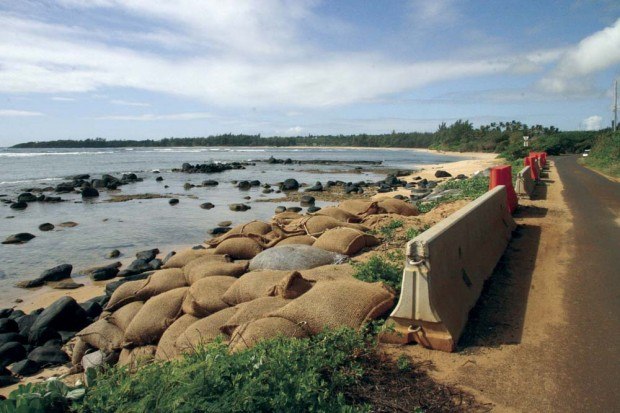ANAHOLA — Kaua‘i residents who reside north of Anahola Bay on ‘Aliomanu Road have dealt with driving on a narrow strip of asphalt along the coast for years. Ocean currents and pounding surf have damaged a 300-foot stretch of the
ANAHOLA — Kaua‘i residents who reside north of Anahola Bay on ‘Aliomanu Road have dealt with driving on a narrow strip of asphalt along the coast for years. Ocean currents and pounding surf have damaged a 300-foot stretch of the street.
The county’s “temporary” fix has been in place for four years, but a more lasting solution that was recently set in stone may begin within one year, according to county spokeswoman Mary Daubert.
“The permanent erosion control project for ‘Aliomanu Road will begin as soon as we receive our permits, hopefully, in the coming fiscal year, FY 2011-2012,” she said in an email last week.
Meanwhile, the ocean keeps surging against the stacks of sandbags.
Erosion control for the road started in 2007 in response to shoreline erosion caused by wave action over the years, Daubert said. The county placed bags of sand wrapped in burlap — indicated in the Environmental Assessment as being the least harmful to the environment — as a temporary measure while waiting on permits for a permanent solution.
“The preliminary design work was completed in 2009,” Daubert said. “We are currently awaiting approval on permits from the U.S. Army Corps of Engineers, state Department of Land and Natural Resources and the state Department of Health to proceed with the emergency repairs.”
Daubert said the scope of work includes reconstructing 300 feet of the road and building a 500-foot revetment wall along the shoreline to protect the road from erosion. Oceanit is the consultant for the project, whose work is estimated to cost $2.5 million.
Temporary repairs
The burlap bags take about a year to deteriorate in salt water, according to Daubert.
The county was scheduled last week to replace the sandbags, but due to a delay in the arrival of new bags, the work was postponed. The county will announce when the project is rescheduled, she said.
A 30-plus-year resident of the area said the county initially used boulders from the ocean to protect the road, but later switched to sandbags. Daubert said she consulted with the county Public Works Department and was told the county did not use boulders.
Before the road was damaged, the sand strip fronting that section of the road used to be much wider. Daubert said the sand is being washed away due to rising water levels and wave action.
A few properties north of the damaged area also show damages from wave action and ocean currents. Some of the properties have a seawall.
The same resident who said the county had used ocean boulders, said the seawalls from nearby properties have been contributing to further wash away the sand nearby. When asked if the resident’s statement was correct, Daubert said the administration was unable to answer the question.
Daubert said she’s not aware of any complaints regarding the ongoing project. She also said the administration in unaware of the bags presenting any danger to marine life or the reef.
• Léo Azambuja, staff writer, can be reached at 245-3681 (ext. 252) or lazambuja@ thegardenisland.com.


